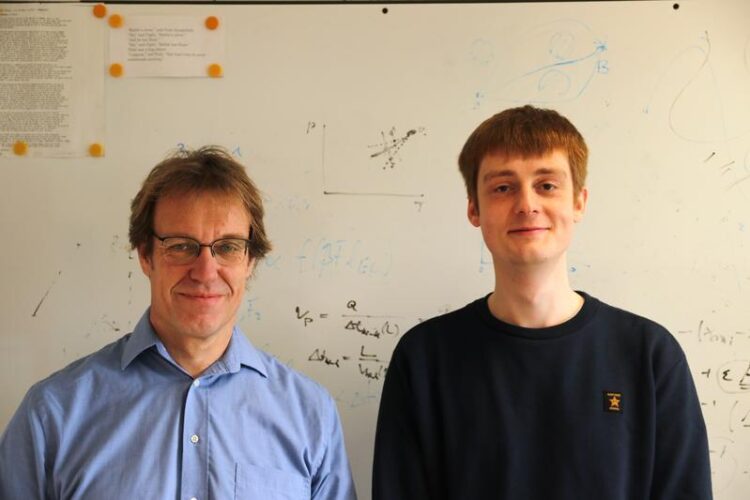Research Team Develops Important Building Block for Artificial Cells

The two researchers involved from the Department of Physics at TU Dortmund University: Professor Jan Kierfeld (left) and doctoral student Lukas Weise (right).
(c) TU Dortmund
During cell division, a ring forms around the cell equator, which contracts to divide the cell into two daughter cells. Together with researchers from Heidelberg, Dresden, Tübingen and Harvard, Professor Jan Kierfeld and Lukas Weise from the Department of Physics at TU Dortmund University have succeeded for the first time in synthesizing such a contractile ring with the help of DNA nanotechnology and to uncover its contraction mechanism. The results have been published in the prestigious journal Nature Communications.
In synthetic biology, researchers try to recreate crucial mechanisms of life in vitro, such as cell division. The aim is to be able to synthesize minimal cells. The research team led by Professor Kerstin Göpfrich from Heidelberg University has now synthetically reproduced contractile rings for cell division using polymer rings composed of DNA nanotubes.
The formation of a ring that constricts and separates dividing cells is an important step in natural cell division. In nature, this is achieved by a machinery of proteins: motor proteins powered by chemical energy from ATP hydrolysis pull together a ring of filaments of the protein actin. Adenosine triphosphate, or ATP, is a molecule that occurs in all living cells and supplies the energy for numerous cellular processes.
The contraction mechanism of the DNA rings developed by the researchers no longer relies on motor proteins powered by ATP hydrolysis. Instead, molecular attraction between ring segments can trigger the contraction of the polymer rings. This molecular attraction can be induced in two ways: either by crosslinking molecules with two “sticky” ends that can connect two polymer segments, or by means of the depletion interaction, where the polymers are surrounded by “crowder” molecules that press the segments together. This mechanism consumes no chemical energy, meaning that no energy source needs to be incorporated in the synthetic cell for the mechanism to function.
Professor Jan Kierfeld, Professor of Theoretical Physics, and doctoral researcher Lukas Weise are working in the field of biological physics. As part of their research work, they have developed a theoretical description and a molecular dynamics simulation of the contraction mechanism, which match the experimental results of their research partners. To this end, they devised special methods for simulating the DNA rings on a realistic scale. Theory and the simulation make it possible to explain quantitatively how the polymer rings form and contract. “This means we are able not only to predict that an increased concentration of ‘crowder’ molecules will make the ring smaller but also by how much smaller,” says Professor Jan Kierfeld. In this way, it is possible to determine how the diameter of the DNA ring can be precisely controlled, which is highly significant for future applications of contractile rings in synthetic biology.
Mechanisms for cell division are an important step towards an artificial cell, the construction of which facilitates a better understanding of the functional mechanisms of natural cells and, thus, of the foundations of life.
Wissenschaftliche Ansprechpartner:
Prof. Jan Kierfeld
Professor for Theoretical Physikcs
TU Dortmund University
Tel.: +49 (0)231 755-3545
E-Mail: jan.kierfeld@tu-dortmund.de
Originalpublikation:
Media Contact
All latest news from the category: Life Sciences and Chemistry
Articles and reports from the Life Sciences and chemistry area deal with applied and basic research into modern biology, chemistry and human medicine.
Valuable information can be found on a range of life sciences fields including bacteriology, biochemistry, bionics, bioinformatics, biophysics, biotechnology, genetics, geobotany, human biology, marine biology, microbiology, molecular biology, cellular biology, zoology, bioinorganic chemistry, microchemistry and environmental chemistry.
Newest articles

NASA: Mystery of life’s handedness deepens
The mystery of why life uses molecules with specific orientations has deepened with a NASA-funded discovery that RNA — a key molecule thought to have potentially held the instructions for…

What are the effects of historic lithium mining on water quality?
Study reveals low levels of common contaminants but high levels of other elements in waters associated with an abandoned lithium mine. Lithium ore and mining waste from a historic lithium…

Quantum-inspired design boosts efficiency of heat-to-electricity conversion
Rice engineers take unconventional route to improving thermophotovoltaic systems. Researchers at Rice University have found a new way to improve a key element of thermophotovoltaic (TPV) systems, which convert heat…



